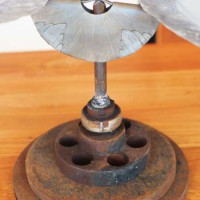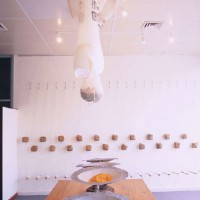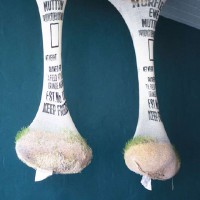Token
Materials:
Sand, coal, tumeric, salt, aluminium, steel, mutton sacks, timber, wool, soil, seeds, water, Native Australian plants and projection.
Concept:
This site-specific work was produced in Newcastle. Newcastle is one of Australia’s largest ports that export resources such as coal, sand and wool to the rest of the world. Using the iconography of rural Australia the exhibition aimed to place economic systems and natural systems under scrutiny. Token confronts the issue of consumerism, asking us to re-evaluate our acquisitions considering their value in terms of cultural and environmental assets instead of monetary value.
Large bulbous mutton bags stretch from the ceiling filled with a variety of substances; sand, coal, turmeric and salt permeate the bags and are collected in sets of scales sculpted from recycled metals. The substances each tell a story; turmeric, refers to the early spice trade; coal is a non-renewable resource that is exported in massive quantities daily through Newcastle harbour; salt is also an export commodity but is indicative of saline soils – a by-product of intensive farming; similarly sand is exported and acts as an iconographical reminder of deserts and Australia’s arid wastelands.
‘Australia’s most pressing environmental problem is the poor state of its soils. Each year it costs around one-billon dollars (AU$) in lost production and restorative action. About two thirds of agricultural and pastoral areas in the country now require special soil treatment of some kind. In Western Australia alone, 250 square kilometres of land is becoming unusable each year due to salinity. Wind and water are causing soils to be washed away 500 times faster than they can be formed.’4
The overgrazing by introduced species, hard hoofed animals such as sheep and cattle, have led to massive damage to the Australian environment. The wool industry is referred to as the backbone of Australia. It is acknowledged in ‘Token’ by the presence of a construction resembling a loom in which miniature bales of woollen fleece are mounted on small shelves. From the bales of wool a yarn is drawn and spun, travelling some meters up the wall over meat hooks and down again to just above floor level where it is collected on timber bobbins. The underlying experience of this space of the exhibition is that of control. It is climate controlled, sterile, measured and accounted for. The presence of a boardroom table confirms the underlying bureaucracy.
Between this room and the foyer a darkened passageway is lit by a wall projection featuring a chart plotting economic and social/cultural values – it is an attempt to evaluate commodities in terms other than profit values.
The foyer is alive with dripping noises. In the humidity, mutton bags are sprouting wheat grass. The growing works have their own sprinkler system intermittently switching on and off occasionally wetting unsuspecting onlookers. Scales are set in motion by the dripping and spraying and collect the excess water and direct it into potted trees situated under the scales.
The trees are Australian native varieties, which produce edible fruits and nuts.
The installation in the foyer exemplifies holistic systems in contrast to the air-conditioned interior space, which reflects poetic images from outmoded and unsustainable practice.
Soil is one of our most fundamental resources. ‘In 1983 a massive dust storm covered Melbourne. It was the result of continued grazing during a prolonged drought in Western Victoria. A quarter of a million tones of precious topsoil was lost in the storm. Planting native trees can do something to help protect our soil, not only to hold the soil in place, but to provide wind breaks which prevent the wind becoming strong enough over a large area to cause serious damage.’5
Promotion for this exhibition involved mailing out over 1000 packets of native seeds in the form of an invitation to the exhibition. The artist collected native seeds on many expeditions in the local region and as far as Sydney in the south and Coffs Harbour in the north. Landcare Australia and Trees in Newcastle volunteers also collected a large quantity of seed for the project. Seed varieties suiting the location to which they were to be sent were allocated, planting instructions and land care messages along with an invitation to the exhibition were distributed.
Project Partners:
Trees in Newcastle, New South Wales, Landcare Australia.
Exhibition:
Intrados Gallery, Newcastle, Australia, 2001.
Publications:
WILCOCK, A.-M. (2001) Today’s Topics. Newcastle Herald. 14th Dec. ed. Newcastle, Australia. P. 9.
STOWELL, J. (2002) Exhibition Review. Newcastle Herald. 22nd Jan. ed. Newcastle, Australia. P. 11.
Thanks:
Benjamin Flanagan
James Thomas
Rob Mylan
Tony Monahan
Victor Nicolas
I.M. Engineering Newcastle.
Endnotes:
4. Quoted from Landcare Australia information leaflet. Unpublished material, Landcare Australia 2000.
5. Quoted from Landcare Australia information leaflet. Unpublished material, Landcare Australia 2000.

















